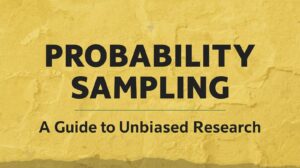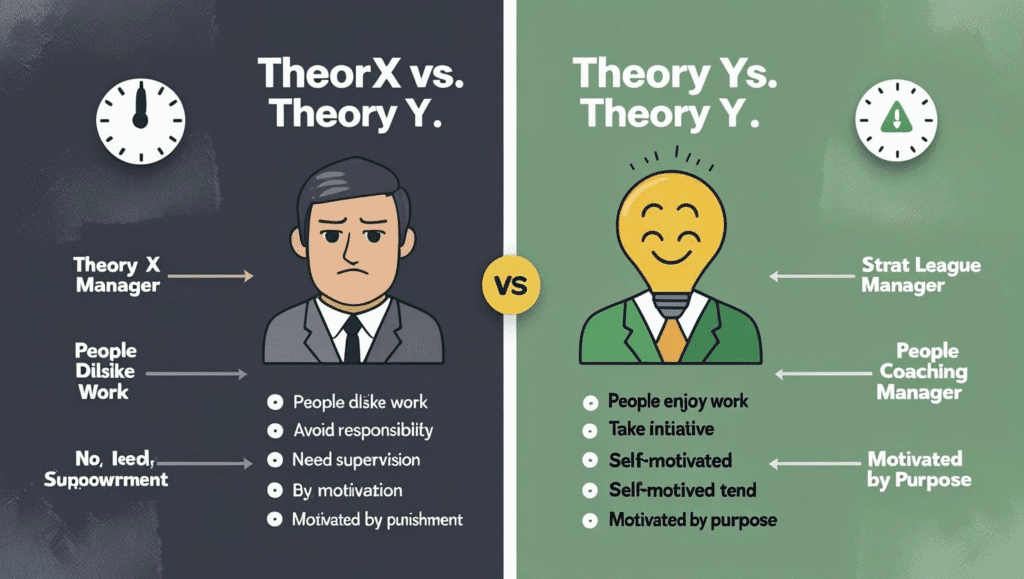Probability Sampling: A Guide to Unbiased Research
In the world of research, data collection, and statistical analysis, the quality of your insights depends entirely on the quality of your sample. How can you be sure that the small group you study accurately reflects the entire population you’re interested in? The answer lies in probability sampling, a cornerstone of scientific research that allows for powerful and reliable conclusions.
This comprehensive guide will walk you through everything you need to know about probability sampling methods. We’ll explore what it is, why it’s crucial for avoiding bias, the different types you can use, and how to choose the right one for your project.
What is Probability Sampling?
Probability sampling is a collection of sampling techniques where every member of a population has a known, non-zero chance of being selected. The selection process is based on the principles of randomization or chance. This fundamental characteristic is what separates it from non-probability sampling and makes it the gold standard for research that aims to generalize findings to a broader population.
The Power of Randomization: Why It Matters
Imagine you want to know the average height of all adults in a city. If you only measure people at a basketball court, your sample will be heavily biased, and your results will be inaccurate. Randomization solves this problem.
By giving everyone an equal opportunity to be included, probability sampling helps to create a sample that is highly representative of the population. It minimizes sampling bias—a systematic error that occurs when some members of the population are more likely to be selected than others. A representative sample allows you to make statistical inferences, which means you can confidently generalize your findings from the sample to the entire population with a known degree of accuracy.
- Reduces Bias: The random nature of selection ensures the sample is more likely to mirror the population’s composition.
- Allows Generalization: Findings from the sample can be applied to the larger population with a calculated level of confidence.
- Enables Statistical Analysis: It allows for the calculation of a margin of error and confidence level, telling you how precise your findings are.
The Four Main Types of Probability Sampling
There isn’t a one-size-fits-all approach to probability sampling. The best method depends on your research goals, resources, and the nature of your population. Let’s break down the four primary types.
1. Simple Random Sampling (SRS)
This is the purest form of probability sampling. In SRS, every individual in the population has an exactly equal chance of being selected. It’s like pulling names out of a hat.
How It Works:
- Define the Population: Clearly identify the entire group you want to study (e.g., all 10,000 employees at a company).
- Create a Sampling Frame: Make a complete list of every single individual in that population. This list is your sampling frame.
- Assign Numbers: Assign a unique number to each individual on the list.
- Select Randomly: Use a random number generator or a lottery method to pick the numbers corresponding to the individuals who will be in your sample.
✅ Pros
- Easiest method to understand.
- Highly representative if the sampling frame is accurate.
- Minimal prior knowledge of the population needed.
❌ Cons
- Requires a complete and accurate list of the entire population, which is often unavailable.
- Can be costly and time-consuming for large populations.
- May not capture key subgroups effectively by pure chance.
2. Systematic Sampling
Systematic sampling is a more streamlined alternative to SRS. It involves selecting individuals at regular intervals from an ordered list.
How It Works:
- Obtain a Sampling Frame: Just like SRS, you need a complete, ordered list of the population.
- Calculate the Sampling Interval (k): Divide the total population size (N) by your desired sample size (n). This gives you your interval, k. For example, if you have 10,000 people and want a sample of 500, k = 10,000 / 500 = 20.
- Choose a Random Start: Select a random number between 1 and k. This is your starting point.
- Select Every k-th Member: Starting from your random number, select every k-th individual on the list until you reach your desired sample size. (e.g., if your start is 7, you’d select individuals 7, 27, 47, 67, and so on).
✅ Pros
- Simpler and faster to execute than SRS.
- Provides a good spread of the sample across the population.
- Less prone to clustering than SRS.
❌ Cons
- Potential for bias if there’s a hidden pattern in the list that aligns with the sampling interval (periodicity).
- Still requires a complete sampling frame.
3. Stratified Sampling
Stratified sampling is used when the population has distinct subgroups (strata) and you want to ensure each subgroup is adequately represented in the sample. This method improves precision.
How It Works:
- Define the Population and Identify Strata: Determine the relevant subgroups. These strata should be mutually exclusive and collectively exhaustive (e.g., categorizing students by year: freshman, sophomore, junior, senior).
- Divide the Population: Separate the entire population into these predefined strata.
- Sample from Each Stratum: Use another probability method (usually Simple Random Sampling or Systematic Sampling) to select a sample from within each stratum. The sample size from each stratum can be proportional to its size in the population (proportional allocation) or equal (disproportional allocation).
✅ Pros
- Ensures representation of all key subgroups.
- Provides greater precision and a smaller margin of error than SRS for the same sample size.
- Allows for separate analysis of each subgroup.
❌ Cons
- More complex to design and execute.
- Requires detailed knowledge of the population’s characteristics to create the strata.
- Can be more expensive and time-consuming.
4. Cluster Sampling
Cluster sampling is useful when a population is spread out geographically or is naturally divided into groups (clusters). In this method, you randomly select entire clusters and then sample individuals from within those selected clusters.
How It Works:
- Define the Population and Identify Clusters: Divide the population into clusters. These clusters should ideally be mini-representations of the population (heterogeneous within, but homogeneous between). Examples include schools in a district, or cities in a state.
- Randomly Select Clusters: Instead of individuals, you randomly select a number of these clusters.
- Sample Within Clusters: You can then either include all individuals from the selected clusters (one-stage cluster sampling) or perform another round of sampling (like SRS or systematic) to select individuals from within the chosen clusters (two-stage cluster sampling).
✅ Pros
- Very practical and cost-effective for large, geographically dispersed populations.
- Doesn’t require a sampling frame of the entire population, only of the selected clusters.
❌ Cons
- Higher sampling error compared to SRS or Stratified sampling; less precise.
- Clusters may not be perfectly representative of the population, introducing potential bias.
- Requires careful design to ensure clusters are comparable.
Choosing the Right Method: A Comparison Table
Feeling unsure which method to use? This table breaks down the key differences to help you decide.
| Factor | Simple Random | Systematic | Stratified | Cluster |
|---|---|---|---|---|
| Best For | Homogeneous populations where a complete list is available. | Homogeneous populations where a list is available and speed is a factor. | Heterogeneous populations with distinct, important subgroups. | Large, geographically dispersed populations where individual lists are impractical. |
| Sampling Frame | Requires a complete list of the entire population. | Requires a complete list of the entire population. | Requires a complete list, along with information on subgroups. | Requires a list of clusters, then a list of individuals only within selected clusters. |
| Precision | Good (baseline) | Good (often slightly better than SRS) | Highest | Lowest (highest sampling error) |
| Cost/Complexity | Can be high for large populations. | Moderate; simpler than SRS. | High; requires more planning. | Low to Moderate; very cost-effective. |
Conclusion: The Foundation of Credible Insights
Probability sampling is more than just a set of techniques; it’s a commitment to rigor and accuracy. By embracing randomization, researchers can minimize bias, create representative samples, and produce findings that can be confidently generalized. Whether you choose the straightforwardness of Simple Random Sampling, the efficiency of Systematic Sampling, the precision of Stratified Sampling, or the practicality of Cluster Sampling, understanding these methods empowers you to conduct more credible, defensible, and impactful research.
The next time you encounter a statistic or a research finding, ask yourself: how was the sample selected? If the answer involves a probability method, you can have greater confidence in the conclusions drawn.
Frequently Asked Questions (FAQ)
What is the main difference between probability and non-probability sampling?
The core difference lies in randomization. In probability sampling, every individual in the population has a known, non-zero chance of being selected. This allows for statistical inference and generalization of results to the entire population. In non-probability sampling, selection is non-random (e.g., based on convenience or judgment), so the results cannot be reliably generalized and are more prone to bias.
How large should my sample be for probability sampling?
The ideal sample size depends on several factors: the size of your population, the desired margin of error (how much you expect your sample results to differ from the true population value), the confidence level (typically 95% or 99%), and the variability within the population. There are standard formulas and online calculators available to determine the appropriate sample size for your research.
Can I use probability sampling for qualitative research?
While probability sampling is the gold standard for quantitative research aiming for generalizability, it can be used in qualitative research, though it’s less common. More often, qualitative studies use non-probability methods like purposive sampling to select information-rich cases. Using probability sampling in a qualitative study can enhance credibility, especially in mixed-methods research.
Is probability sampling always the best choice?
Not necessarily. While it is the best method for making statistically valid inferences about a population, it can be expensive, time-consuming, and sometimes impossible if a complete list of the population (a sampling frame) is not available. For exploratory research, pilot studies, or when resources are limited, non-probability sampling methods can be a more practical and appropriate choice.


